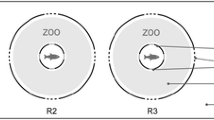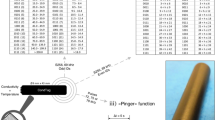Abstract
Behavioural early warning responses to polluted surface water from an industrial effluent have been measured in two freshwater macroinvertebrate species using the four electrode impedance conversion technique. Specimens ofGammarus pulex (L.) andHydropsycho angustipennis (Curtis) were caught from reference streams and exposed to water from above and below the factory and to reference water for about 1 h with different kinds of behaviour being registered on-line every 10 min, such as time spent on locomotion, number of “high swimming peaks”, number of activity phases, cleaning, time spent on ventilation, ventilation frequency and netspinning. Additionally, G.pulex was exposedin situ above and 100 m, 500 m and 1000 m below the factory for 24 h.
G.pulex reacted to water pollution within 1 h with less time spent on locomotion, fewer “high swimming peaks” and lower number of activity phases (p < 0.01). The same results were found after thein situ exposure (p < 0.05) and the pollution gradient mirrored survival and behavioural performance of the organisms.
H. angustipennis reacted to water pollution within 1 h with decreased time spent on ventilation (p < 0.001), no change in locomotion and netspinning during daytime. During the night, exposure to water pollution resulted in increased locomotion (p < 0.0001).
Simultaneous multispecies on-line biomonitoring of industrial effluents is recommended for reliable risk assessment.
Similar content being viewed by others
References
Aunaas, T.;Olsen, A. &Zachariassen, K. E. (1991): The effects of oil dispersants on the amphipodGamtnarus oceanicus from artic waters. Polar Res. 10 (2) 619–630
Beitinger, T. L. (1990): Behavioral reactions for the assessment of stress in fishes. J. Great Lakes Res. 16 (4) 495–528
Blaxter, J. H. &Halles-Tjabbes, T. (1992): The effect of pollutants on sensory systems and behaviour of aquatic animals. Netherlands Journal of Aquatic Ecology 26 (1) 43–58
Borcherding, J. &Volpers, M. (1993): The “Dreissena-Monitor”. First Results on the Application of this Biological Early Warning System in the Continuous Monitoring of Water Quality. Proceedings of the Conference “Rehabilitation of the River Rhine”, Arnhem, March 1993
Borlakaglu, J. T. &Klckuth, R. (1990): Behavioural changes inGammarus pulex and its significance in the toxicity assessment of very low levels of environmental pollutants. Bull. Environm. Contam. Toxicol. 45, 258–265
Brittain, J. E. &cEikeland, T. J. (1988): Invertebrate drift — A review. Hydrobiologia 166, 77–93
Cairns, J. &Pratt, V. H. (1993): A history of biological monitoring using benthic macroinvertebrates. In:Rosenberg, D. M. &Resh, W. A. (Eds.) Freshwater biomonitoring and benthic macroinvertebrates, Chapman & Hall, New York, London, 488 pp
Cushing, C. E. (1963): Filter-feeding insect distribution and planktonic food in the Montreal River. Transactions of the American Fischeries Society 92, 216–219
Crane, M., Delaney, P., Watson, S., Parkers, P. &Walker, C. (1995): The effect of malathion 60 onGamtnarus pulex (L.) below watercress beds. Environmental Toxicology and Chemistry 14 (7) 1181–1188
Crane, M. &Maltby, L. (1991): The lethal and sublethal responses ofGamtnarus pulex to stress: Sensitivity and sources of variation in an in situ bioassay. Environmental Toxicology and Chemistry 10, 1331–1339
Decamps, H., Besch, W. K. &Vobis, H. (1973): Influence de produits toxiques sur la construction du filet des larvesd’Hydropsy ehe (Insecta, Trichoptera). C. R. Acad. Sci. Paris, Serie D 276, 375–378
Depledge, M. H. &Fossi, M. C. (1994): The role of biomarkers in environmental assessment. 2. Invertebrates. Ecotoxicology 3 161–172
Depledge, M. H. (1989): The rational basis for detection of the early effects of marine pollutants using physiological indicators. Ambio 18 (5) 301/302
Dodson, S. I., Hanazato, T. &Gorski, P. R. (1995): Behavioral responses ofDaphnia pulex exposed to carbaryl andChaoborus kairomone. Environmental Toxicology and Chemistry 14 (1) 43–50
Garmendia Tolosa, A. J. &Axelsson, B. (1993):Gammarus, their biology, sensitivity and significance as test organisms. FVL-report B 1095, 88pp, SEPA, Stockholm
Georgian, T. &Thorp, J. H. (1992): Effects of microhabitat selection on feeding rates of netspinning caddisfly larvae. Ecology 73, 229–240
Gerhardt, A.;Clostermann, M.;Fridlund, B. &E. Swensson (1994): Monitoring of behavioural patterns of aquatic organisms with an impedance conversion technique. Environment International 20 (2) 209–219
Gerhardt, A. (1995a): Effects of metals on stream invertebrates. PhD thesis, 188 pp, Lund University, Lund, Sweden
Gerhardt, A. (1995b): Monitoring Behavioural Responses to Metals inGamtnarus pulex (L.) (Crustacea) with Impedance Conversion. Environ. Sci. & Pollut. Res. 2 (1) 15–23
Gerhardt, A. &Janssens DE Bisthoven, L. (1995): Behavioural, developmental and morphological responses ofCbironomus gr.thummi larvae (Diptera, Nematocera) to aquatic pollution. J. Aquat. Ecosystem Health 4, 205–214
Gerhardt, A. &Westermann, F. (1995): Effects of precipitations of iron hydroxides onLeptophlebia marginata (L.) (Insects: Ephemeroptera) in the field. Arch. f. Hydrobiol. 133 (1) 81–93
Heinis, F., Timmermans, K. R. ©Swain, W. R. (1990): Short-term sublethal effects of cadmium on the filter-feeding chironomid larvaGlyptotendipes pallens (Meigen) (Diptera). Aquatic Toxicology 16, 73–86
Hultin, L. (1971): Upstream movements ofGammarus pulex pulex (Amphipoda) in a South Swedish stream. Oikos 22, 329–347
Lawton, J. H. (1994): What do species do in ecosystems? Oikos 71, 367–374
Maltby, L.;Naylor, C. &Calow, P. (1990): Effects of stress on a freshwater benthic detritivore: Scope for Growth inGammarus pulex. Ecotoxicology and Environm. Saf. 19, 285–291
Maltby, L. &Crane, M. (1994): Responses ofGammarus pulex (Amphipoda, Crustacea) to metalliferous effluents: Identification of toxic components and the importance of interpopulation variation. Environmental Pollution 84, 45–52
Maltby, L. (1995): Sensitivity of the crustaceansGammarus pulex (L.) andAsellus aquaticus (L.) to short-term exposure to hypoxia and unionized ammonia: Observations and possible mechanisms. Water Research 29 (3) 781–787
Matthiessen, P., Sheahan, D., Harrison, R., Kirby, M., Rycroft, R., Turnbull, A., Volkner, C. &Williams, R. (1995): Use ofGammarus pulex bioassay to measure the effects of transient carbofuran runoff from farmland. Ecotoxicology and Environmental Safety 30, 111–119
McNichol, R. E. &Scherer, E. (1991): Behavioural responses of Lake Whitefish (Coregonus clupeaformis) to cadmium during preference-avoidance testing. Environm. Toxicol. Chem. 10, 225–234
Meijering, M. P. O. (1971): TheGammarus fauna of flowing waters in the area of Schlitz. Archiv. f. Hydrobiologie 68, 575–608
Miron, G., Brock, V. &Kristensen, E. (1994): Effects of mercury on the ventilation behaviour of the polychaeteNereis virens (Sars). Journal of Experimental Marine Biology and Ecology 184, 67–81
Moriarty, F. (1988): Ecotoxicology — The Study of Pollutants in Ecosystems. 2 ed. Academic Press, London, San Diego, 289 pp
Muirhead-Thomson, R. C. (1978): Lethal and behavioral impact of permethrin NRDC-143 on selected stream macro invertebreates. MOSQ-News 38 (2) 185–190
Pascoe, D.;Kedwards, T. J.;Maund, S. J.;Muthi, E. &Taylor, E. J. (1994): Laboratory and field evaluation of a behavioural bioassay — TheGammarus pulex (L.) precopula separation (GaPPS) test. Water Research 28 (2) 369–372
Petersen, L. B. M. &Petersen R. Jr. (1984): Effect of kraft pulp mill effluent and 4,5,6 trichloroguaiacol on the net spinning behaviour ofHydropsyche angustipennis (Trichoptera). Ecological Bulletin (Stockholm) 36, 68–74
Petersen, R. Jr. (1986): Population and guild analysis for interpretation of heavy metal pollution in streams. In:Cairns, J. Jr. (Ed.): Community toxicity testing. ASTM STP 920, American Society for Testing and Materials, Philadelphia, 180–198
Plenet, S. (1995): Freshwater amphipods as biomonitors of metal pollution in surface and interstitial aquatic systems. Freshwater Biology 33, 127–137
Rosenberg, D. M. &Resh, W. A. (eds.) (1993): Freshwater biomonitoring and benthic macroinvertebrates. Chapman &C Hall, New York, London, 488 pp
Scherer, E. (1992): Behavioural responses as indicators of environmental alterations: approaches, results, developments. J. Appl. Ichthyol. 8, 122–131
Semlitsch, R. D., Fogila, M., Mueller, A., Steiner, I., Firomonti, E. &Fent, K. (1995): Short-term exposure to triphenyltin affects the swimming and feeding behavior of tadpoles. Environmental Toxicology and Chemistry 14 (8) 1419–1423
Stuijifzand, S. C., Kraak, M. H. S., Wink, Y. A. &Davids, C. (1995): Short-term effects of nickel on the filtration rate of the zebra musselDreissena polymorpha. Bull. Environ. Contam. Toxicol. 54, 376–381
Taylor, E. J.;Jones, D. P. W.;Maund, S. J. &Pascoe, D. (1993): A new method for measuring the feeding activity ofGammarus pulex (L.) Chemosphere 16 (7) 1375–1381
Udalova, G. P.;Karas, A. Y. &Zhukovskaya, M. I. (1990): Asymmetry in the movement direction inGammarus oceanicus in the open field test. Zh-Vyssh-Nervn-Deyat-Im-I-P-Pavlova 40 (1) 93–101
Vuori, K. M. (1994): Rapid behavioural and morphological responses of hydropsychid larvae (Trichoptera, Hydropsychidae) to sublethal cadmium exposure. Environm. Pollut. 84, 291–299
Vuori, K. M. (1995): Species- and population-specific responses of translocated hydropsychid larvae (Trichoptera, Hydropsychidae) to runoff from acid sulphate soils in the River Kyrönjokl, western Finland. Freshwater Biology 33, 305–318
Vuori, K. M. & Parkko, M. (1995): Life cycles, microdistribution and incidence of gill abnormalities in theHydropsyche pellucidula andCheumatopsyche lepida larvae (Trichoptera, Hydropsychidae) in the polluted river Kymijoki. Archiv f. Hydrobiologie
Wallace, J. B. &Merritt, R. W. (1980): Filter-feeding ecology of aquatic insects. Annual Review of Entomology 25, 103–132
Warner, P. H. (1967): Bioassays for microchemical environmental contaminants with special reference to water supplies. Bull. WHO. 36, 181–207
Williams, K. A.;Green, D. W. J. &Pascoe, D. (1984): Toxicity testing with freshwater macroinvertebrates: Methods and application in environmental management. In:Pascoe, D. &Edwards, R. W. (Eds.) Freshwater Biological Monitoring. Pergamon Press, London, pp 81–93
Wingard, C. J. &Swanson, C. J. (1992): Ventilatory responses of four marine teleosts to acute rotenone exposure. J. Appl. Ichthyol. 8, 132–142
Author information
Authors and Affiliations
Rights and permissions
About this article
Cite this article
Gerhardt, A. Behavioural early warning responses to polluted water. Environ. Sci. & Pollut. Res. 3, 63–70 (1996). https://doi.org/10.1007/BF02985490
Received:
Accepted:
Issue Date:
DOI: https://doi.org/10.1007/BF02985490




